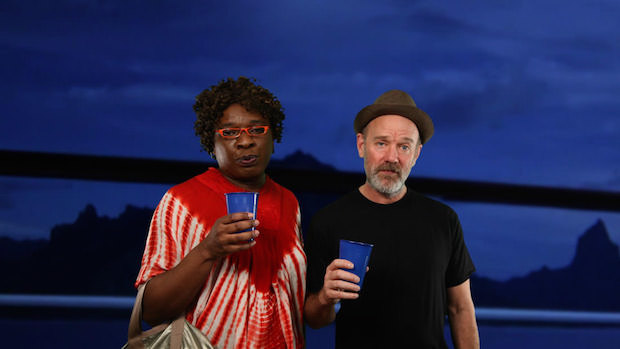 Back to selection
Back to selection
Video Artist Kalup Linzy on His Sundance Installation Queen Rose Family (da Stories)
 Queen Rose Family (da stories)
Queen Rose Family (da stories) Video and performance artist Kalup Linzy returns to Sundance in 2016 with Queen Rose Family (da Stories), an installation within the New Frontier program of the festival. The exhibit features prominent musicians such as Michael Stipe and Tunde Adebimpe of TV on the Radio and was was shot, directed, edited and scored by Linzy himself. Hailing from New York, Linzy has had pieces at The Met, The MoMA and The Whitney, among other museums. In this interview for Queen Rose Family (da Stories), Linzy talks shop about how he captured the distinctly campy aesthetic of his latest installation.
Filmmaker: How and why did you wind up being the cinematographer of your film? What were the factors and attributes that led to your being hired for this job?
Linzy: I did the hiring. I work as the cinematographer on my films and I hire co-cinematographers or assistants to help. Or I recruit students or post grads to work with me.
Filmmaker: What were your artistic goals on this film, and how did you realize them? How did you want your cinematography to enhance the filmʼs storytelling and treatment of its characters?
Linzy: I was interested in getting my videos to look more cinematic by using color correcting techniques. In addition, I used the green screen to communicate the idea of DIY collage similar to mixed media collages that will be presented on the wall. Some of the characters in the videos are grayscale against backgrounds that are in color intended to reference the early style of film tinting. Others are in natural settings with basic white balance.
Filmmaker: Were there any specific influences on your cinematography, whether they be other films, or visual art, of photography, or something else?
Linzy: Yes. I am influenced by classic Hollywood black and white films as well as Warhol films. Soap operas, still photography. I am also interested in creating scenes that look unreal and more like a fantasy, with an artifice feel without undercutting some of the emotion and topics addressed. Other scenes in the mashup include scenes that look like typical independent films or documentary scenes intended to frame the characters in spaces that feel like real life.
Filmmaker: What were the biggest challenges posed by production to those goals?
Linzy: Hoping it feels like an intended experimental piece that has a sense of coming together or more to be explored and not the feel of a failed attempt at something that feels all over the place.
Filmmaker: What camera did you shoot on? Why did you choose the camera that you did? What lenses did you use?
Linzy: Canon 5D Mark II, because it works well in low lighting and gorilla style type productions. I used the Canon EF 24-105mm f/4L IS USM Standard Zoom Lens.
Filmmaker: Describe your approach to lighting.
Linzy: I use basic three point lighting for inside scenes. For exterior shots, I wait for the sun to either be fully exposed or for an overcast. The final exterior scene usually ends up being the scene with the overcast.
Filmmaker: What was the most difficult scene to realize and why? And how did you do it?
Linzy: There is a scene in Conversations Wit De Churen X: One Life To Heal, which is in the installation, when my character Taiwan was confronted by his ex (Humberto Petit) with his current boyfriend (Leo Fitzpatrick) standing with him. I was struggling with keying out the green screen without losing the character’s Taiwan flower or face, which also happened in a previous scene. This was the moment I began experimenting with the characters being grayscale and the backgrounds in color. I also experimented with extreme close ups, that I started doing in Melody Set Me Free (2012) that weren’t green screen. A lot of cropping, filtering, overlaying happened with that scene.
Filmmaker: Finally, describe the finishing of the film. How much of your look was “baked in” versus realized in the DI?
Linzy: The scenes with the standard white balance are closer to being “baked in”. The scenes that are green screen are realized as I am shooting editing, constantly thinking it through. I also don’t use story boards. I scout a location, figure how I am going to frame the shot, using the standard long, medium, and close up shots from a angle. Occasionally, portrait shots are used.
- Camera: Canon 5D Mark II
- Lenses: Canon-EF 24-105mm f/4L IS USM Standard Zoom
- Lighting: Three point lighting, interior scenes and natural for exterior shots Processing: Sharpen filter 10-30%, Gaussian blur 2-4%, Gamma 1.0-2.5, Flicker Filter Maximum
- Color Grading: Color correction with the bottom layer with above mentioned processing. The top layer includes the same filters as the bottom layer, except the top layer is converted to a grayscale and composited with the soft light mode.
